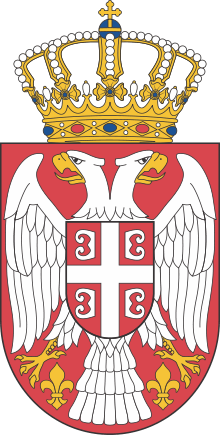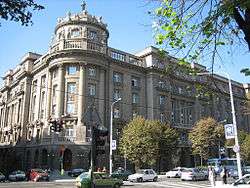Ministry of Foreign Affairs (Serbia)
|
Министарство спољних послова Ministarstvo spoljnih poslova | |
 | |
 Ministry of Foreign Affairs building | |
| Agency overview | |
|---|---|
| Formed | 1811 |
| Jurisdiction | Government of Serbia |
| Headquarters |
24-26 Kneza Milosa St. 11000 Belgrade |
| Annual budget | RSD 7.016 billion (2008) |
| Minister responsible | |
| Agency executives |
|
| Website |
www |
The Ministry of Foreign Affairs (Serbian: Министарство спољних послова / Ministarstvo spoljnih poslova) is a ministry in the government of Serbia responsible for maintaining the consular affairs and foreign relations of Serbia. The current minister of foreign affairs is Ivica Dačić, since 27 April 2014.[1]
History
The foreign policy and diplomatic tradition of Serbia derive from its independent state in the twelfth, thirteenth and fourteenth centuries. Specific foreign policy and diplomatic experience of the Serbian state was drawn upon the vassal or autonomous state of the Serbian people during the various periods of the Ottoman domination in the Balkans, from the fifteenth to the nineteenth centuries.
In the nineteenth century, when the movement for independence from the Ottoman Empire became irrepressible, especially after the First Serbian Uprising (1804) under Karađorđe and the Second Uprising (1815) under Miloš Obrenović, Serbia embarked upon an ever broader diplomatic rapport with the Porte in Constantinople, with Russia, Austria, Great Britain, France, Germany, Italy and other European nations and neighboring states, such as Romania, Bulgaria and Greece. Serbia became fully independent and internationally recognized at the Congress of Berlin in 1878.
Among the states with which Serbia established diplomatic relations first (before that time diplomatic relations were limited to certain diplomatic functions) were Russia, Austria, Great Britain, France, Germany, Italy and a number of other European countries. The diplomatic relations with the United States, however, were established only in 1882, through the ratification of the Convention on trade and navigation and the Convention on consular relations.
Following the end of World War I, in which Serbia fought on the side of the Entente, Serbia became part of the Kingdom of Yugoslavia.
In the interwar period the Kingdom was a founding member of the League of Nations and of the Little Entente with Romania and Czechoslovakia as well as of the Balkan Treaty with Romania, Greece and Turkey. The Kingdom's joining of the Axis Tripartite Pact on March 25, 1941 was revoked, by the will of the Serbian people, on the streets of Belgrade two days later.
During World War II, in which Yugoslavia was allied against the Axis Powers, a new Yugoslav federal state came into being that was proclaimed and internationally recognized in 1945.
The Socialist Federal Republic of Yugoslavia was a founding member of the United Nations in 1945 and of the Conference on Security and Cooperation in Europe in 1975. It was also one of the founders of the Non-Aligned Movement, which held two summit conferences in Belgrade, in 1961 and 1989. In the early fifties Yugoslavia was a member of the Balkan Treaty with Greece and Turkey.
Officials and organization
 |
| This article is part of a series on the politics and government of Serbia |
|
Legislature |
|
Judiciary |
The current Minister of Foreign Affairs is Ivica Dačić. The State Secretary is Vera Mavrić[2] and the Secretary General is Zoran Marković. Assistant Ministers are Goran Aleksić for bilateral relations, Roksanda Ninčić for multilateral affairs, Duško Lopandić for the European Union, Zoran Vujić for security policy, and Šani Dermaku for consular affairs.[3]
Organization scheme of the ministry:[4]
- Office of the Minister
- Diplomatic Protocol
- Special Services
- Service for Investigation and Documentation
- Security Service
- Service for International Legal Affairs
- Translations Service
- ICT Department
- Secretariat General
- Directorate of Personnel and Legal Affairs
- Accounts and Payments Directorate
- Directorate of Archival Affairs
- Service for Property-Legal, General and Common Affairs
- Out-of-Hours Contact Office
- Inspector General
- Office of the State Secretary
- Directorates General
- Directorate General of Bilateral Relations
- Directorate for Neighboring and South-East European Countries
- Directorate for Europe
- Directorate for Russia and Eurasia
- Directorate for Americas
- Directorate for Africa and the Middle East
- Directorate for Asia, Australia and the Pacific
- Directorate of Bilateral Economic Cooperation
- Directorate for Borders
- Directorate General of Multilateral Cooperation
- Directorate for the United Nations
- OSCE and CoE Directorate
- Directorate of Multilateral Economic Cooperation
- Directorate of Human Rights and Protection of the Environment
- Directorate General for the European Union
- Directorate for the Institutions of the European Union Countries
- Directorate for Sectoral Affairs
- Directorate for Regional Initiatives
- Directorate General for NATO and Defense Affairs
- Directorate for NATO
- Partnership for Peace Directorate
- Directorate for Weapons Control
- MoD Coordination Section
- Directorate General of Information and Culture
- Directorate of Information
- Directorate of International, Cultural, Educational, Scientific, Technological and Sports Cooperation
- Directorate General of Consular Affairs and Diaspora
- Directorate of Consular Affairs
- Directorate of Development, Diaspora and Social Security Conventions
- Directorate General of Bilateral Relations
- Directorates General
- Councils
- Council for Foreign Policy Strategy
- Legal Council of the MFA
- Diplomatic Academy
Serbian representation abroad
Serbia has a significant number of diplomatic missions abroad, representing its growing ties with the West along with Yugoslavia's historical ties with eastern Europe and the Non-Aligned Movement.
Serbia inherited about a third of the diplomatic facilities that belonged to the former Yugoslavia. After 2001 embassies in Chile, Colombia, the Democratic Republic of the Congo, Ghana, Guinea, Lebanon, Mongolia, North Korea, Pakistan, Thailand, Venezuela, Vietnam and Zimbabwe were closed due to financial or reciprocal reasons. In June 2008, the government of Serbia made the decision to close consulates in Bari, Graz and Malmö,[5] and later that year Foreign Minister Vuk Jeremić announced plans to open a consulate-general in Knin, Croatia[6] and an embassy in Kuala Lumpur, Malaysia.[7]
On November 30, 2006, the Government of Serbia adopted the Memorandum of Agreement between the Republic of Montenegro and the Republic of Serbia on Consular Protection and Services to the Citizens of Montenegro. By this agreement, Serbian diplomatic missions provide consular services to the Montenegrin citizens on the territory of states in which Montenegro has no missions of its own.[8]
Ministry of Foreign Affairs maintains the following missions abroad:[9]
- 65 embassies;
- 23 consulates in 15 countries;
- 55 honorary consuls;
- 7 diplomatic missions to the: COE, EU, NATO, OSCE, UN - New York, UN - Geneva, and UNESCO.
Serbia hosts 65 foreign embassies in Belgrade, 5 Consulates-Generals (two in Niš and Subotica and one in Vršac) and 4 Liaison offices (in Priština). Serbia also hosts representatives of the Palestinian National Authority and Sovereign Military Order of Malta and 13 Honorary Consuls, some accredited as Ambassadors.[10]
Diplomatic Academy
The first modern law on diplomatic service was passed in 1886 during the reign of King Milan. The Diplomatic Academy was formed in 1998 from the former diplomatic school of the Ministry of Foreign Affairs.
Diplomatic Archive
The diplomatic archive of the Ministry of Foreign Affairs is based on former activities of the diplomatic archive of the Kingdom of Serbia and Kingdom of Yugoslavia. It was founded on May 5, 1919 on the basis of the Decree, and it consisted of Documentation and Library of the Ministry, taken over from the Ministry of the Kingdom of Serbia and Montenegro. The Main Archive started to operate more effectively in the fall of 1924 since it was then that the Minister of Foreign Affairs formed an expert commission whose task was to inspect gathered documents on the creation of the Kingdom of Serbs, Croats and Slovenes, and make a plan of future operation of the Main archive. The Law on archives of the Ministry of Foreign Affairs and diplomatic and consular missions of the Kingdom of Yugoslavia abroad has from April 5, 1930 been precise in stating which holdings of the archive would become part of the Main Archive. The Diplomatic Archive has published the collections of public documents on foreign affairs of the SFRY between 1945 and 1950 in eight volumes called Blue edition.
See also
- Foreign relations of Serbia
- Minister of Foreign Affairs (Serbia)
- Ministry of Foreign Affairs (Yugoslavia)
References
- ↑ Minister of Foreign Affairs Ivica Dačić. Ministry of Foreign Affairs of Serbia.
- ↑ State Secretary of the Ministry of Foreign Affairs of Serbia
- ↑ Ministry of Foreign Affairs - Officials
- ↑ The Organisational Structure of the Ministry of Foreign Affairs
- ↑ "Vlada zatvara konzulate u Gracu i Malmeu" (in Serbian). RTV. 16 June 2008.
- ↑ "Srbija otvara konzulat u Kninu" (in Serbian). RTV Studio B. 28 May 2008. Retrieved 3 December 2010.
- ↑ "Malaysia freezes recognition procedure". B92. 11 August 2008.
- ↑ Memorandum on Services to Montenegrin Citizens Takes Effect
- ↑ "Serbian Diplomatic Missions". Ministry of Foreign Affairs of Serbia. Retrieved 20 June 2013.
- ↑ "Foreign Diplomatic Missions" (PDF). Ministry of Foreign Affairs of Serbia. Retrieved 20 June 2013.
